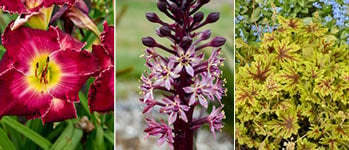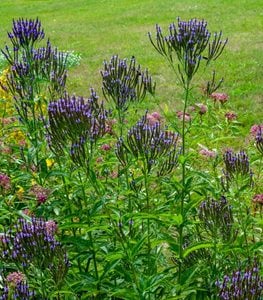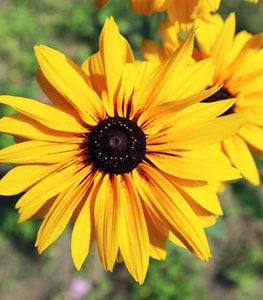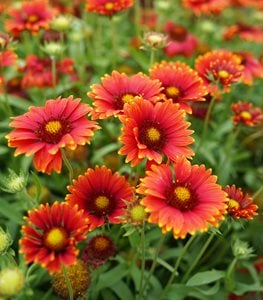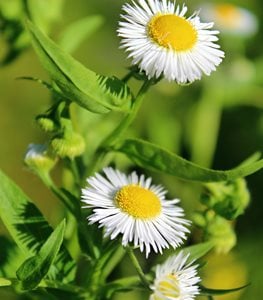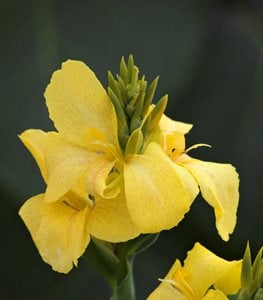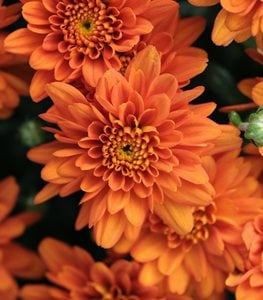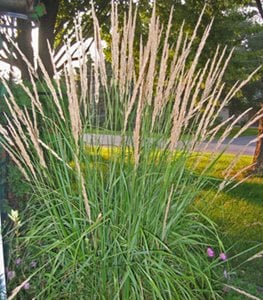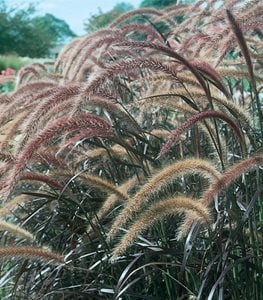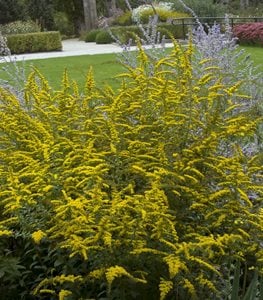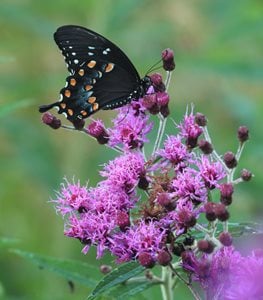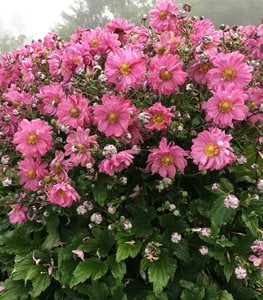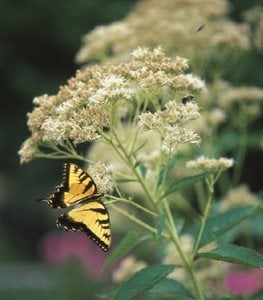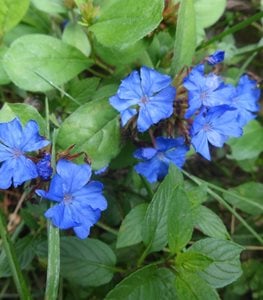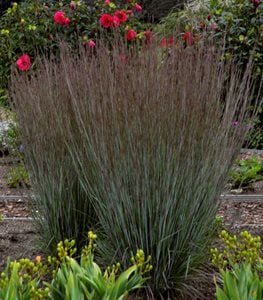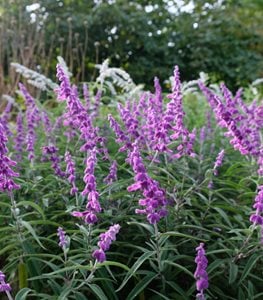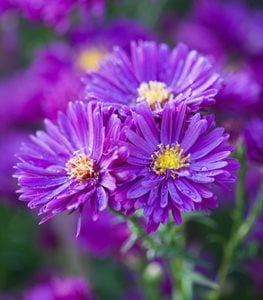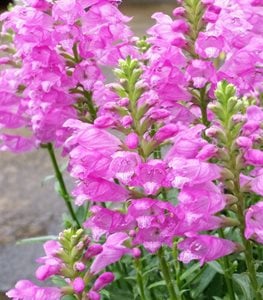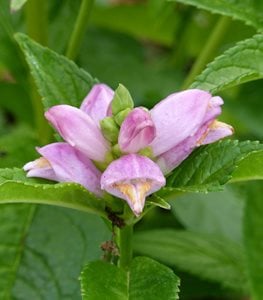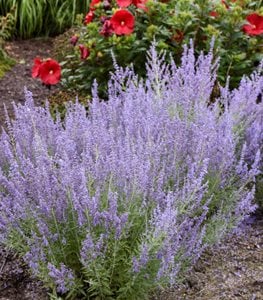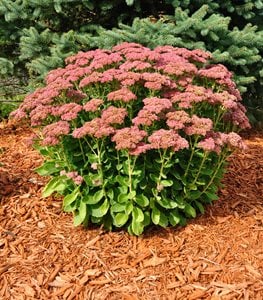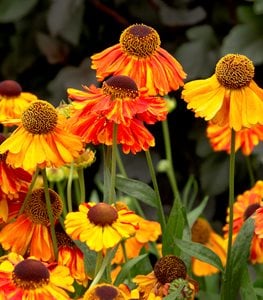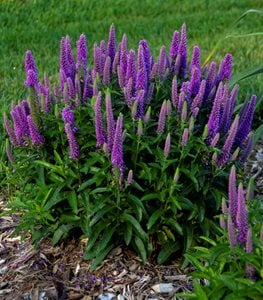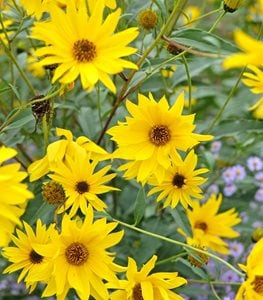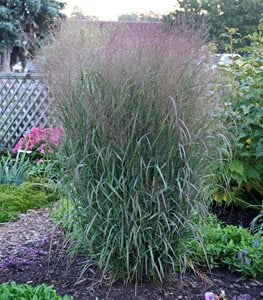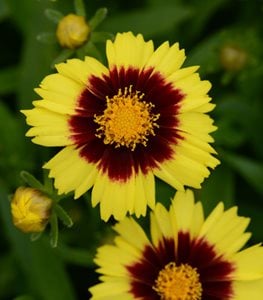25 Fabulous Fall-Blooming Perennials
Add late season color to your landscape with these reliable fall bloomersFall is the time when gardens begin to wind down before going dormant for the winter. Though home landscapes can look a bit tired toward the end of the growing season, there are many perennials that bloom in fall that can breathe new life into your late-season landscape.
When choosing fall-blooming perennials, make sure they are hardy to your region to insure years of returning color. If you live in a colder region, plant early in the season to allow these perennials to become established.
Combine fall-blooming perennials with trees, shrubs, and other perennials with late-season ornamental attributes such as fall foliage, berries, seed pods, or fruit for a captivating display. Here are some of the best fall blooming perennials to add to your yard.
FALL-BLOOMING PERENNIALS
AMERICAN BLUE VERVAIN (Verbena hastata)
Zones: 3-8
Exposure: Full sun
Habit: Upright habit
Height/Spread: 2 to 5 feet tall, 1 to 3 feet wide
Bloom time: Summer to fall
Blue vervain is a native wildflower with pale lavender star-shaped flowers on tall branching stems. This rhizomatous perennial is virtually carefree and is found growing natively in moist ditches, marshes, and meadows. Plant in a rain garden, native border, or meadow.
BLACK-EYED SUSAN (Rudbeckia spp.)
Zones: 3-9
Exposure: Full sun
Habit: Upright habit
Height/Spread: 1 to 4 feet tall, 1 to 2 feet wide
Bloom time: Summer to fall
This reliable long-lived perennial is a classic late-season bloomer for cottage-style gardens, mixed borders, and meadow landscapes. Daisy-like flowers occur in rich fall tones of gold, bronze, and brown. Flowers are a source of nectar for pollinators, while the seed heads provide food for songbirds and other wildlife. Learn more about growing black-eyed Susan.
BLANKET FLOWER (Gaillardia spp.)
Zones: 3-10
Exposure: Full sun
Habit: Compact mounding habit
Height/Spread: 1 to 3 feet tall, 1 to 2 feet wide
Bloom time: Summer to fall
Blanket flower produces daisy-like flowers in cheerful hues of yellow, orange, coral, and red. Native to the western U.S., this short-lived perennial thrives in lean soil and dry sunny conditions. Use this long bloomer in a waterwise strip, mixed border, or along a slope. Learn more about growing blanket flower.
Pictured: Heat it Up® Scarlet blanket flower from Proven Winners.
BOLTONIA (Boltonia asteroides)
Zones: 3-10
Exposure: Full sun
Habit: Upright spreading habit
Height/Spread: 3 to 6 feet tall, 2 to 4 feet wide
Bloom time: Late summer to fall
Also known as false aster, the dainty flowers of this eastern U.S. native resemble chamomile, small daisies, or asters. Prolific clusters of white flowers smother the plant for a spectacular late-season display. Plant in a mixed border or natural area in combination with other fall bloomers such as Japanese anemone and obedient plant.
CANNA (Canna spp.)
Zones: 7-11
Exposure: Full sun
Habit: Upright spreading habit
Height/Spread: 1-1/2 to 8 feet tall, 1-1/2 to 6 feet wide
Bloom time: Mid-summer to fall
Add tropical flair to fall landscapes with canna's exotic blooms and bold foliage. Flowers occur in warm hues of red, yellow, orange, pink, and coral. Use this rhizomatous perennial in mixed borders, containers, or mass plantings. Learn more about growing canna plants.
Pictured: Toucan ® Yellow from Proven Winners.
CHYRSANTHEMUM (Chrysanthemum spp.)
Zones: 5-9
Exposure: Full sun
Habit: Upright or mounding habit
Height/Spread: 1 to 3 feet tall, 1 to 2 feet wide
Bloom time: Fall
Better known as mums, this quintessential flower for fall gardens comes in a wide array of colors and forms. Potted mums are commonly sold and displayed in fall as annuals, but can also be planted in the ground and treated as perennials. Display in containers, beds, and borders. Learn more about growing mums.
FEATHER REED GRASS (Calamagrostis x acutiflora 'Karl Foerster')
Zones: 5-9
Exposure: Full sun to partial shade
Habit: Upright open habit
Height/Spread: 3 to 6 feet tall, 2 to 3 feet wide
Bloom time: Summer to fall
One of the most popular ornamental grasses, ‘Karl Foerster’ produces tall open spikes of beige flower plumes that add texture and movement to mixed borders, curbside strips, and waterwise landscapes. Plants are tolerant of a wide range of growing conditions including heat and clay soil.
Pictured: 'Karl Foerster' feather reed grass from Proven Winners.
FOUNTAIN GRASS (Pennisetum spp.)
Zones: 6-9
Exposure: Full sun to partial shade
Habit: Mounding habit
Height/Spread: 1 to 4 feet tall and wide
Bloom time: Summer to fall
Fountain grass is a warm season ornamental grass with showy bottlebrush flowers that start out reddish-purple or pink, aging to tawny brown. Plants provide texture and movement in the landscape as well as winter interest. Use in a mixed border, mass planting, or curbside strip alongside other ornamental grasses and fall bloomers.
Pictured: Graceful Grasses® purple fountain grass from Proven Winners.
GOLDENROD (Solidago spp.)
Zones: 3-10
Exposure: Full sun
Habit: Upright spreading habit
Height/Spread: 1 to 7 feet tall, 1 to 6 feet wide
Bloom time: Late summer to fall
Goldenrod is a native wildflower with golden yellow flower spikes that attract butterflies, bees, and other late-season pollinators. Plants are tolerant of drought and poor soils, and resistant to pests and diseases. Naturalize this long-blooming herbaceous perennial in a meadow, native border, or pollinator garden. Learn more about growing goldenrod.
IRONWEED (Vernonia spp.)
Zones: 4-9
Exposure: Full sun
Habit: Upright habit
Height/Spread: 2 to 12 feet tall, 1 to 6 feet wide
Bloom time: Mid-summer to fall
This underused native plant deserves a spot in the fall landscape, with its towering growth habit and spidery purple or pink flowers that are highly attractive to late-season pollinators. Place at the back of a mixed border, in a meadow garden, or natural landscape.
JAPANESE ANEMONE (Anemone x hybrida)
Zones: 4-8
Exposure: Full sun
Habit: Upright spreading habit
Height/Spread: 1 to 4 feet tall and wide
Bloom time: Late summer to fall
Japanese anemone produces elegant single or double poppy-like flowers in shades of pink or white. Plants bloom over an exceptionally long time, throughout late summer and fall. Use this easy-to-grow herbaceous perennial in a cottage-style garden or mixed border in combination with ornamental grasses and other fall bloomers. May spread aggressively in some areas. Learn more about growing anemone plants.
Pictured: Fall in Love® ‘Sweetly’ Japanese anemone from Proven Winners.
JOE PYE WEED (Eutrochium spp.)
Zones: 3-9
Exposure: Full sun
Habit: Upright spreading habit
Height/Spread: 3 to 8 feet tall, 1 to 5 feet wide
Bloom time: Mid-summer to fall
Native to North America, Joe pye weed can be found growing in roadside ditches, moist meadows, and woodland thickets. Showy pink or white flower plumes are a favorite late-season nectar source for migrating butterflies, bees, and other insect pollinators. Plant this stately herbaceous perennial in a meadow garden or toward the back of a mixed border. Learn more about growing Joe pye weed.
LEADWORT (Ceratostigma plumbaginoides)
Zones: 5-9
Exposure: Full sun to partial shade
Habit: Low mounding habit
Height/Spread: 8 to 12 inches tall, 12 to 24 inches wide
Bloom time: Mid-summer to mid-fall
Leadwort produces vivid blue flowers with green foliage that turns shades of red in fall for dramatic contrast. This mat-forming perennial ground cover helps to stem erosion and is tolerant of a range of growing conditions. Plant in rock gardens, waterwise strips, and as edging along pathways or borders.
LITTLE BLUESTEM (Schizachyrium scoparium)
Zones: 3-9
Exposure: Full sun
Habit: Upright habit
Height/Spread: 2 to 4 feet tall, 1 to 2 feet wide
Bloom time: Late summer to fall
Little bluestem is a hardy ornamental grass native to North American prairies. Grown for the finely textured blue-green foliage, reddish-brown flower spikes and brilliant fall color, this reliable perennial also adds winter interest to the landscape. Plant this medium-sized grass in a meadow, mixed border, or native garden.
Pictured: Prairie Winds® 'Blue Paradise' little bluestem from Proven Winners.
MEXICAN BUSH SAGE (Salvia leucantha)
Zones: 8-10
Exposure: Full sun
Habit: Bushy habit
Height/Spread: 2 to 5 feet tall and wide
Bloom time: Late summer to frost
Mexican bush sage is a shrubby tender perennial that produces showy purple, pink, or white flower spikes with a velvety texture. The flowers are attractive to bees and other insect pollinators. Plant alongside sedum and coneflower in a mixed border, waterwise landscape, or as a showy focal point.
NEW ENGLAND ASTER (Symphyotrichum novae-angliae)
Zones: 4-8
Exposure: Full sun
Habit: Upright spreading habit
Height/Spread: 2 to 6 feet tall, 1 to 3 feet wide
Bloom time: Late summer to fall
This eastern North American native grows in the wild along moist areas such as stream banks, lakes, and roadside ditches. Daisy-like flowers in colors of purple, lavender, pink, or white are a favorite of butterflies and other insect pollinators. Naturalize in a rain garden, native border, or meadow landscape. Learn more about growing aster plants.
OBEDIENT PLANT (Physostegia virginiana)
Zones: 3-9
Exposure: Full sun to partial shade
Habit: Upright spreading habit
Height/Spread: 3 to 4 feet tall, 2 to 3 feet wide
Bloom time: Mid-summer to fall
Obedient plant is named for the tendency of the flowers to remain in a new position if they are bent. This upright herbaceous perennial produces pastel pink or white tubular flowers that bloom from the bottom to the top of the stem. Plants spread through dense rhizomes and are best naturalized in a meadow, native border or garden.
PINK TURTLEHEAD (Chelone lyonii)
Zones: 3-8
Exposure: Full sun to partial shade
Habit: Upright spreading habit
Height/Spread: 2 to 4 feet tall, 2 to 3 feet wide
Bloom time: Late summer to fall
Pink turtlehead is a hardy clump-forming perennial with lance-shaped green foliage and spikes of tubular pink flowers. The hooded flowers are reminiscent of a turtle head emerging from its shell, hence the name. Plant this moisture lover in a rain garden or allow to naturalize in a native border.
RUSSIAN SAGE (Perovskia atriplicifolia)
Zones: 4-9
Exposure: Full sun
Habit: Upright spreading habit
Height/Spread: 2 to 4 feet tall and wide
Bloom time: Early summer to fall
Russian sage produces frothy lavender-blue flower spikes that last for weeks from late summer into fall. This tough herbaceous perennial makes a good substitute for lavender plants in colder climates. Combine with black-eyed Susan or sneezeweed (Helenium) in mixed borders or mass plantings for complementary contrast. Learn more about growing Russian sage.
Pictured: 'Denim 'n Lace' Russian sage from Proven Winners.
SEDUM 'AUTUMN JOY' (Hylotelephium telephium 'Herbstfreude')
Zones: 3-9
Exposure: Full sun
Habit: Upright habit
Height/Spread: 1 to 2 feet tall and wide
Bloom time: Mid-summer to fall
This tough carefree succulent produces fleshy green leaves and dense clusters of tiny flowers for weeks of late-season color. Tiny buds open to pink star-shaped flowers that change to rich rose, then coppery brown as they age. Use this herbaceous perennial to edge borders, in waterwise strips, or massed in the landscape. Learn more about growing sedum and stonecrop.
SNEEZEWEED (Helenium spp.)
Zones: 4-8
Exposure: Full sun
Habit: Upright bushy habit
Height/Spread: 3 to 4 feet tall, 1 to 3 feet wide
Bloom time: Summer to early fall
Cheerful daisy-like flowers bloom in profusion for weeks during summer and fall. Flowers occur in warm autumn colors of orange, yellow, and red. Native to North America, sneezeweed grows in moist meadows and damp woodlands. Plant this herbaceous perennial in a mixed border, native garden, or meadow landscape.
SPEEDWELL (Veronica spp.)
Zones: 3-9, depending on the variety
Exposure: Full sun to partial shade
Habit: Upright or creeping habit
Height/Spread: 3 to 48 inches tall, 8 to 24 inches wide
Bloom time: Late spring to fall, depending on the variety
Speedwell is a versatile ground cover or upright perennial with flower clusters or tall spires in cool tones of purple, lavender, blue, pink, or white. Most upright varieties bloom through summer, with some repeat bloom into fall. Plant in mixed borders or mass in the landscape. Learn more about growing speedwell plants.
Pictured: Magic Show® ‘Purple Illusion’ spike speedwell from Proven Winners.
SUNFLOWER (Helianthus spp.)
Zones: 3-10
Exposure: Full sun
Habit: Upright habit
Height/Spread: 2 to 10 feet tall, 1 to 4 feet wide
Bloom time: Summer to fall
Though most gardeners are familiar with the showier annual sunflowers, this reliable perennial provides late-season color year after year. Yellow daisy-like flowers bloom in profusion over a long time from late summer into fall. This stately plant, which is adaptable to a wide range of growing conditions, can be used towards the back of a mixed border or naturalized in a native garden. Learn more about growing sunflowers.
SWITCHGRASS (Panicum virgatum)
Zones: 4-8
Exposure: Full sun to partial shade
Habit: Upright arching or vase-shaped habit
Height/Spread: 3 to 8 feet tall, 1-1/2 to 5 feet wide
Bloom time: Late summer to fall
Switch grass is a native warm-season ornamental grass grown for the cloud-like flower plumes and colored foliage that add texture and movement to the landscape. This reliable perennial remains attractive throughout winter months. Grow in a mixed border, mass planting, or native garden. Learn more about growing switchgrass.
Pictured: Prairie Winds® ‘Apache Rose’ switchgrass from Proven Winners.
TICKSEED (Coreopsis spp.)
Zones: 3-9
Exposure: Full sun
Habit: Upright mounding habit
Height/Spread: 1 to 4 feet tall, 1 to 3 feet wide
Bloom time: Late spring to fall, depending on the variety
Daisy-like single or double flowers occur in single or bicolor shades of yellow, red, orange, coral, or white. Tickseed blooms for weeks, is heat and drought tolerant, and is virtually carefree once established. Combine with other fall bloomers such as Joe pye weed, goldenrod, and ornamental grasses in a native landscape or meadow garden. Learn more about growing tickseed.
Pictured: Uptick™ Yellow & Red from Proven Winners.
RELATED:
The Best Flowers for Your Fall Garden
Fall Gardening Tips & Chores
More on Growing Perennials
